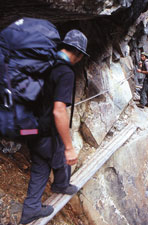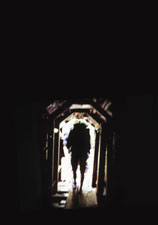Japan’s last secret alpine garden, the highland source of the Kurobe River, is surrounded by 2,500 to 3,000-meter peaks. Beautiful gorges and valleys are cut from the rock walls, the backdrop for our hike along the former Nippon Electric Company road, a path forged through these mountains with great human sacrifice.
 Kurobe Gorge lies along the Tateyama ridge of Japan’s Northern Alps, backed by another range featuring Hakuba and Kashimayari-ga-take. The gorge is carved out by the Kurobe River, which flows forth from an area shared by three prefectures – Nagano, Gifu and Toyama – as it makes a swift 86 km. descent on the Toyama side toward the Sea of Japan.
Kurobe Gorge lies along the Tateyama ridge of Japan’s Northern Alps, backed by another range featuring Hakuba and Kashimayari-ga-take. The gorge is carved out by the Kurobe River, which flows forth from an area shared by three prefectures – Nagano, Gifu and Toyama – as it makes a swift 86 km. descent on the Toyama side toward the Sea of Japan.
The completion of the Kurobe #4 Hydroelectric Dam in 1961 created Lake Kurobe. Shimonoroka (lower corridor) is further up stream followed by Okushimonoroka (interior lower corridor). It is here, at the river’s source where, up until recent history, there were no human tracks, and, until completion of the dam, the only footprints were left by the most experienced of climbers.
 Departures
Departures
“This sucks,” I thought to myself as I ran up the steps of Shinano-Omachi Station on the Ohito Line, spotting my friends waiting on the opposite platform. There would be just four of us on this trip – adventurer and author of “Traveler’s Tune” Shotaro Takahashi, “Off the Tourist Track” writer Ryo Sumigawa, the young writer Shinya Moriyama and myself. We were scheduled to hop the 10 a.m. Super Azusa express train from Shinjuku, which would put our group in Shinano-Omachi just after 1 p.m., but I arrived at Shinjuku just in time to watch the tail end of the train carrying my three companions disappear down the track. A delay on the line near my home brought me to the platform one minute past being on time.
The next train was an hour later and required a transfer at Matsumoto, putting me in Shinano-Omachi after 3 p.m. This would be followed by a bus and trolley, finishing off with a one-hour hike before finally arriving at the Kuroyon Lodge Campground. With the October sun setting soon I was pleased to see my friends patiently waiting at the Shinano-Omachi Station when I arrived. No words were exchanged, except the obligatory, “I’m sorry.”
No sooner had the words rolled off my tongue, we were on the bus for Ogisawa, the door shutting just as we boarded. I looked at the faces of my traveling partners and was relieved to know I would not be hiking the mountain paths alone at sundown.
 Toward Shimonoroka
Toward Shimonoroka
Our plan was to leave the campground for a two-day hike down through Shimonoroka then board a tram headed for Keyakidaira Station on the Kurobe Gorge Line. From there another tram would take us as far as Unazuki where we would transfer to a JR line ending up in Toyama. The final leg of the four-night, five-day trip would be a bus from Toyama at 11 p.m. returning to Ikebukuro the next morning.
Early morning on the second day we packed up our tent and made for the main attraction, Kurobe Dam, along a leisurely lakeside path over smooth, level ground. This would be the prelude to the real hiking. After descending the stairs running along the height of the dam (186 m), we continued along the river and eventually crossed to the left bank, our trail for the next two days.
 Examining the map, the mountain road winding from Kurobe’s #4 Dam to the Sennindani Dam is labeled as the “Old NEC Road.” Before World War II Nippon Electric Company chiseled the road from the mountain in preparation for the construction of these hydroelectric dams – a project not without its share of casualties.
Examining the map, the mountain road winding from Kurobe’s #4 Dam to the Sennindani Dam is labeled as the “Old NEC Road.” Before World War II Nippon Electric Company chiseled the road from the mountain in preparation for the construction of these hydroelectric dams – a project not without its share of casualties.
The road runs atop precarious cliffs and danger seems to be around every turn. Bedrock shaved from the walls lines the left side of the path with a singular wire cable strung along to act as your guide. There are no rails on the right to help you on your way, and slipping from the 40-50 cm. path would mean a quick and decidedly unpleasant fall.
The season for visiting is limited to six weeks between the middle of September and the end of October. The Kurobe region experiences some of Japan’s heaviest snowfall, and, therefore, the time between snowmelt in the valley and the first storm of winter is extremely short. Additionally, before the route is open to the public an extensive check must be performed on the guide wire, which acts as a traveler’s lifeline, as well as for snow levels and avalanche dangers.
We continued hiking for the better part of eight hours, finally reaching the Sennindani Dam. Before hiking the final hour to the campsite, we decided to enjoy an extended break on the flat top of the dam, particularly welcome due to the lack of suitable rest areas on the way up. The long hike on bedrock caused our feet to ache, but one last push through the concrete corridors along the dam and in the Kansai Electric train tunnel lead us to a welcome sight – Azohara Onsen and our campground.
 Crossing the “Horizon” to Toyama
Crossing the “Horizon” to Toyama
The trek to Keyakidaira took place on the third day, with the majority of our hike running along the “Horizon Trail,” which, according to the contours of the map, was level up until one kilometer from our destination. At one point we passed through vinyl-lined tunnels cut from the bedrock to keep hikers dry and protected from the valley’s swamp water.
These tunnels require climbers to take extra care in their preparations, particularly placing flashlights and headlamps in easy to reach places. The longest tunnel runs 150 meters with a bend in the middle, meaning limited light and a tough passage without the proper gear. Also, the high humidity and increasingly narrow tunnel width tend to fog things up. A relatively bright light in your gear bag is definitely recommended, as less powerful lights would require you to feel your way through the better part of the tunnel. A pare of non-slip soled boots aren’t a bad idea for negotiating the wet rocks.
It is also worth mentioning that trekking poles won’t be of much use. I ended up bringing one along, but quickly found it wasn’t much use. The path is narrow and a pole only becomes a nuisance and liability. Even if you strap the pole to your backpack you risk loosing your balance when it clips the bedrock above your head.
After passing over the “Horizon” we boarded what can only be described as a miniature toy train with a roof and no windows for the trip to Unazuki. From there, our journey ended in Toyama for a taste of the city’s nightlife.
 Getting There
Getting There
Lake Kurobe is reachable from Ogisawa (40 minutes by bus from Shinano-Omachi Station on the Shinanomachi Line) on the Nagano side via a 15-minute trolley bus ride. On the return, it’s a one-hour, twenty-minute tram ride from Keyakidaira to Unazuki along the Kurobe Railway, followed by another train ride to Toyama. Note the Shimonoroka route is usually open from mid-September until early October, but it is best to confirm snow conditions by contacting the mountain patrol (076-465-5778, available from mid-April until late November) or Kuruyon Lodge at Azohara Onsen.
Web Connection
Tateyama-Kurobe Alpen Route: www.alpen-route.com
Kurobe Gorge Railway: http://www.kurotetu.co.jp
Note: Both web sites available in Japanese, English, Korean, Cantonese and Mandarin.




